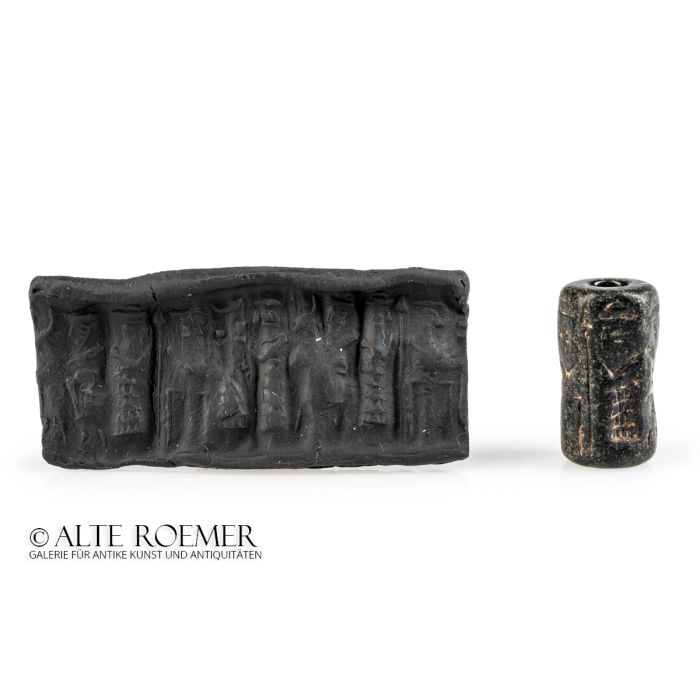Cylinder seal with seated god
Price: on request
Sold
Object number
AR3117B
| Object: |
Mesopotamian cylinder seal with sky god
|
| Material: |
Black stone, probably Serpentinite.
|
| Period: |
Akkad III period, from the rule of Naram-Sin until the end of Akkadian rule. 23rd cent. BC. Early Bronze Age. |
| Description: | Cylindrical seal with through hole along the central axis. A scene with several figures is engraved into the mantle of the seal. The seal impression shows the sky god on his throne, with worshippers before him. They hold cups and one is riding an animal. |
| Background: |
Cylinder seals have been invented by the early civilizations of Mesopotamia. From the 4th Millenium BC onwards they conquered the whole Near East and beyond.
The emergence of this type of seal coincides with the first abundant use of scripture to manage the young highly organized city states. Such early seals are therefore a glimpse at the beginnings of civilization in Mesopotamia. Later seals broaden the view to all areas of administration, but also to trade and even personal matters. Many officials, traders and private persons must have possessed cylinder seals during the Bronze Age of Mesopotamia. What a happy instance for today's historians. Cylinder seals were made of durable materials and survived the millenia nearly unchanged. A treasury of images and inscriptions is reaching out to us from the Bronze Age. Thanks to the diverse original owners many stray finds have been made in the Near and Middle East. After the interest in antiquity has been reborn in Europe such finds have been preserved and valued. Many pieces could be attended to in private and public collections. And because of academic excavations with documented find contexts a chronology could be worked out. Today, also the stray pieces on the art market and in collections can be dated by iconographic means. For us it is a very special sensation to hold such seals in our hands and reflect the rise and fall of civilizations. |
| Dimensions: |
19mm length, 11mm diameter.
|
| Preservation: |
Wear to the surface and tiny, otherwise very good condition.
|
| Provenance: |
Acquired by us on the British art market in 2020. The seal was previously in the posession of a London gallery. It was part of the Bonhams London Knightsbridge auction "Antiquities", 1 December 1999, lot 244. Previously in the Erlenmeyer Collection, acquired between 1943 and around 1965. The couple Prof. Hans Erlenmeyer (1900-1967) and Marie-Louise Erlenmeyer (1912-1997) shared a passion for the ancient cultures of the Middle East and the Eastern Mediterranean. Between 1943 and around 1965 they built an impressive collection of artefacts from that region located in Switzerland. Numerous publications were inspired and a valuable bridge was built between collectors and the world of academia. Objects from the collection have often been on display in international exhibitions or in the nearby Basel Museum of Antiquities. In the years 1988 to 1999 the collection was finally returned to the art cycle. It required no less than seven auctions at the renowned auction houses Christie's and Sotheby's bearing the title "Erlenmeyer" and one auction at Bonhams. The proceeds flowed into the Swiss Erlenmeyer Foundation, which was founded by Mrs. M.-L. Erlenmeyer in order to use its funds to finance nature conservation projects and in particular animal welfare projects. We hope that the treasures from the Erlenmeyer Collection will inspire further generations of collectors and researchers alike. |
| References: |
Cf. H. Keel-Leu, B. Teissier, Die vorderasiatischen Rollsiegel der Sammlungen BIBEL + ORIENT der Universität Freiburg Schweiz, Orbis Biblicus et Orientalis, volume 200 (2004), nos. 69 and 70.
|
| Authenticity: |
We guarantee the authenticity of this object and all works of ancient art sold by us for life.
|


